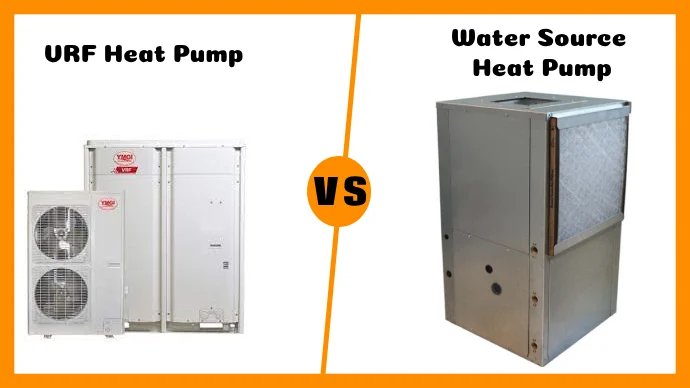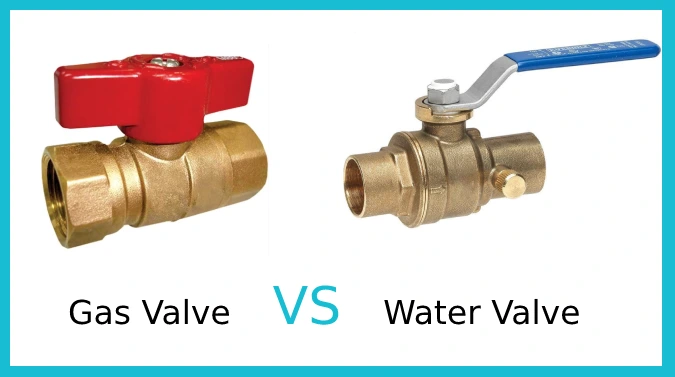Last Updated on June 21, 2023
Commercial and residential buildings have several options when it comes to HVAC systems. Two of them are variable refrigerant flow (VRF) and water source heat pumps. Although these two systems both use refrigerant to transfer cold and heat, they differ in several ways.
When comparing Water Source Heat Pumps (WSHPs) and Variable Refrigerant Flow (VRF) systems, the key differences lie in their operational methods, efficiency, flexibility, compatibility, system footprint, and controls.
However, the most notable discrepancy between these two options is efficiency. WSHPs have a track record of reducing building energy consumption by a staggering 44%, surpassing VRF systems in this important aspect.
Facility managers and building owners need to understand these differences to make an informed choice when choosing an HVAC system.
Let’s discover the distinctions: between VRF & water source heat pumps. Comparing energy savings, lifespan, and cold weather efficiency.
VRF vs Water Source Heat Pump: Key Differences

This discussion will explore the key differences between VRF and water source heat pump systems, focusing on six key points.
- System Operation and Efficiency
- System Flexibility and Compatibility
- Installation and Maintenance
- System Size and Cost
- Energy Efficiency and Climate Adaptability
- System Footprint and Controls
One: System Operation and Efficiency
The system operation and efficiency section provides a detailed analysis of two energy-efficient HVAC systems that operate differently. The VRF system modulates the refrigerant flow to serve different zones with varying heating and cooling requirements.
It’s a highly efficient system with heating, cooling, and heat recovery features that reduce energy costs in the long run. Its ability to minimize duct losses and operate better at partial loads makes it a worthy contender for both residential and commercial buildings.
The WSHP system, on the other hand, transfers heat via water, making it suitable for hot and cold climates. It provides simultaneous heating and cooling, helping to recover energy while maintaining high-efficiency standards.
The WSHP is known for its superior efficiency, leading to significant energy savings compared to other systems.
Two: System Flexibility and Compatibility
In comparing VRF and WSHP systems, the focus is on their flexibility and compatibility with other equipment. VRF systems are not flexible and have proprietary controls that make integrating other equipment from different manufacturers difficult. As a result, costs can rise and efficiency can be reduced.
WSHP systems, however, are versatile and can be integrated with various HVAC components, including boilers, chillers, and cooling towers. WSHP systems also offer more design flexibility, making them suitable for various building types and optimizing space utilization.
Therefore, WSHP systems are better for those seeking flexibility and compatibility in system design, integration, and controls.
Three: Installation and Maintenance
Comparisons between VRF and WSHP should consider installation and maintenance procedures. VRF systems are complex and require extensive installation training, while WSHP systems are simpler to install due to their standardized design.
Maintenance for VRF systems can also be more challenging, as the risk of refrigerant leaks is higher, and leak detection can be difficult. On the other hand, WSHP systems have a smaller refrigerant charge, making leak detection and isolation easier.
Additionally, WSHP systems allow for future modifications and reuse of existing components during renovations, making them a more sustainable option. In the case of a building renovation or expansion, VRF systems may need more extensive modifications.
Four: System Size and Cost
When choosing between VRF units and WSHP systems, size and cost are important factors. VRF units are available in various sizes, making them suitable for both residential and high-rise buildings. However, they’re expensive, ranging from $18-20 per square foot served, which makes them less cost-effective.
VRF units are typically chosen for new construction or system replacements, but their installation cost is higher compared to alternatives.
In contrast, WSHP systems are suitable for any building size, with a smaller system footprint than VRF units. Commercial buildings commonly use WSHP systems for heating and cooling. Their cost-effectiveness comes from their ability to provide both.
Five: Energy Efficiency and Climate Adaptability
VRF and WSHP systems are two popular heating and cooling options in commercial buildings. VRF systems are known for their high energy efficiency in hot climates but can be expensive to operate in cold weather.
On the other hand, WSHP systems are highly efficient in both hot and cold climates and meet the highest standards ASHRAE sets. They are also quieter and more energy efficient than other systems.
WSHP systems have an advantage over VRF systems in terms of climate adaptability. They perform well in extreme weather, including temperatures as low as -20°F. WSHP systems also use a water loop to transfer heat rather than electric heat, so they have a smaller carbon footprint and use less energy.
Six: System Footprint and Controls
WSHP and VRF systems differ in their footprints and controls. VRF systems tend to take up more space due to their outdoor units and refrigerant piping, whereas WSHP systems have a smaller footprint because they don’t require individual outdoor units.
Additionally, WSHP systems place their cooling towers and boilers away from occupied areas, which reduces noise and allows for greater design flexibility. Both types of systems feature advanced controls that allow for precise temperature regulation and energy-efficient operation.
They may also be integrated with building automation systems for centralized monitoring and control. VRF and WSHP systems need to be chosen based on the specific needs of the building in question, including space, noise levels, and control preferences.
How much energy savings can be expected with VRF systems?

VRF systems are highly effective in reducing energy consumption and improving energy efficiency. This is because they provide only the necessary amount of cooling based on the present conditions of space, so they run less and use less power.
VRF systems also ensure that energy is not wasted in cooling or heating areas that do not require it. They are designed to control the temperature of different zones within a building separately.
Studies have shown that VRF systems can achieve significant energy savings. The Pacific Northwest National Laboratory found that energy savings of up to 34% compared to older systems can be achieved with VRF systems.
Meanwhile, the National Renewable Energy Laboratory has reported that VRF systems demonstrate notable energy savings of up to 40% compared to traditional HVAC systems. Conducted studies indicate that VRF systems provide a highly effective solution to reduce energy consumption and improve energy efficiency.
What is the lifespan of water source heat pump systems?
Typically, the longevity of water sources lasts approximately 20-25 years with maintenance and may extend to 30 years. However, the prospect of your unit surviving for 30 years is improbable, hence necessitating replacement.
Proper upkeep is necessary to extend the lifespan of a heat pump. Such upkeep includes regular maintenance, cleaning coils, changing air filters, and checking refrigerant levels.
These maintenance practices can help prevent common problems like refrigerant leaks, compressor failures, and clogged air filters that can shorten a heat pump’s lifespan. Air filters for heat pumps should be frequently replaced as it has been found that this practice can extend the lifespan of heat pumps up to two years.
How long does a Variable refrigerant flow (VRF) last?
The lifespan of a VRF system depends on the frequency of maintenance and the system’s location. Generally, a VRF system can last for 10 to 15 years if proper maintenance procedures are followed.
The frequency of maintenance for VRF systems varies depending on where they are installed. Maintenance is typically carried out twice a year in administrative buildings, exhibition centers, and business centers. However, maintenance may only be carried out once a year in other locations, such as residential buildings.
Proper maintenance includes cleaning the filters, checking the refrigerant charge, inspecting the electrical connections, and ensuring the system runs efficiently. By following these procedures, the lifespan of a VRF system can be extended.
Which system is more efficient at heating in cold weather: VRF or water source heat pump?

When comparing the efficiency of HVAC systems in cold weather, outdoor air and electric resistance heating performed better than just air source heat pumps. However, this study did not specifically compare VRF systems to water source heat pumps.
Overall, VRF systems have higher heating and cooling efficiency than traditional HVAC systems due to their ability to modulate refrigerant flow based on building needs. Additionally, VRF systems can recover waste heat to improve energy efficiency.
However, extremely cold weather may decrease VRF system efficiency as they rely on outdoor air for heat exchange. Water source heat pumps offer consistent efficiency in colder weather conditions as they use water as the heat exchange medium, which can maintain a more consistent temperature.
Sustainable HVAC: Water Source Heat Pumps vs. VRF Systems
In our pursuit of a sustainable future, it is paramount that we carefully evaluate our choice of heating and cooling systems. Water Source Heat Pumps and Variable Refrigerant Flow (VRF) systems have emerged as two viable options, each with its unique strengths and limitations.
Refrigerant-based systems can offer up to 30% energy savings compared to traditional systems. Water source heat pumps have a longer lifespan, making them a better investment in the long run. Conversely, VRF systems are more efficient in colder weather as they can adjust the flow rate to meet changing load demands.
Ultimately, it comes down to picking the right system based on energy savings, lifespan, and weather efficiency. A decision that can significantly impact not only your present-day operations but also the environment around you.



